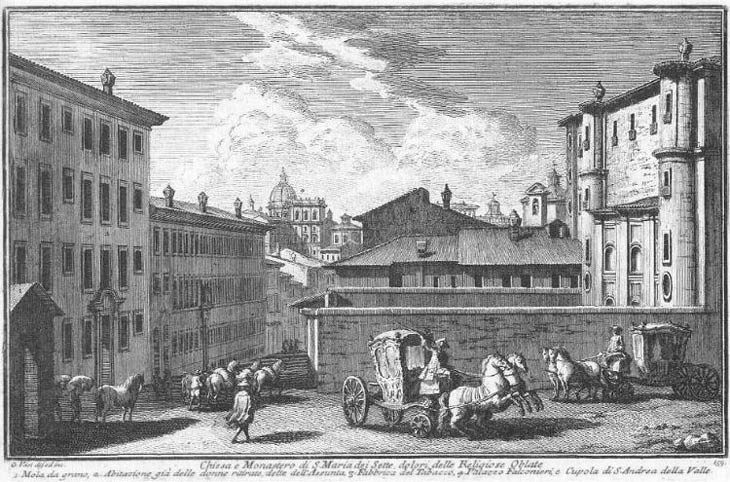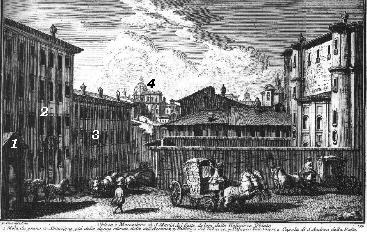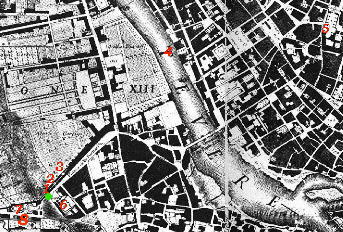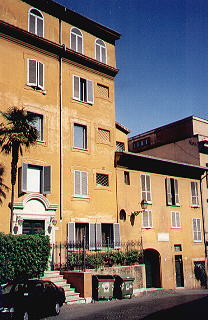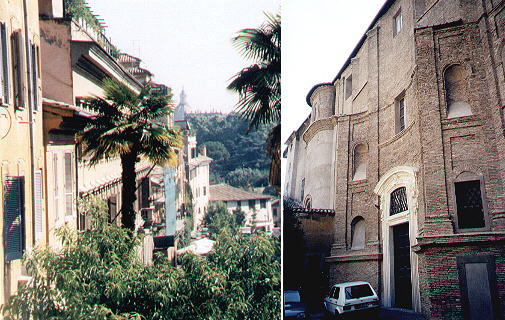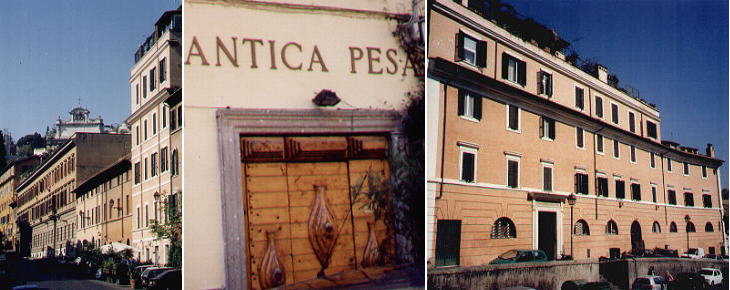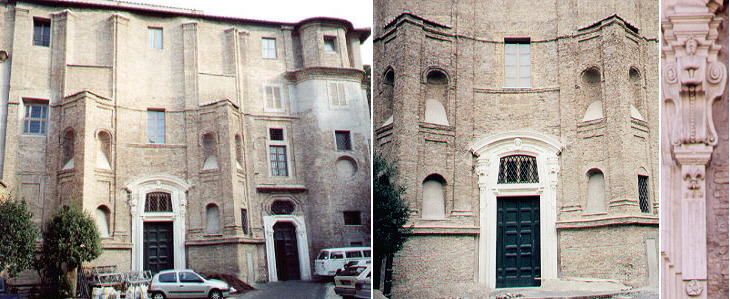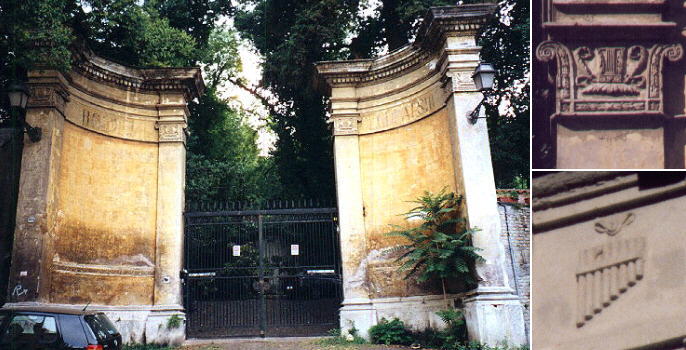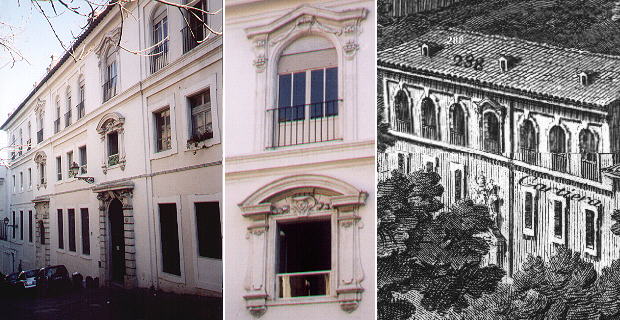

Chiesa
e Monastero di S. Maria dei Sette Dolori (Book
8) (Map
D3) (Day 6) (View E10) (Rione Trastevere)
In this page:
The plate by Giuseppe Vasi
Today's view
The Nunnery
Bosco degli Arcadi
Cartiera Sanpieri
The Plate (No. 159)
The view is taken from the slopes of the Janiculum. Making use of the water
falls of the Acqua Paola mills (Mola da Grano), a paper-mill (Cartiera)
and a tobacco factory (Fabbrica
del Tabacco).were established here. The view is taken from the green dot in the 1748 map below.
In the description below the plate Vasi made reference to: 1) Mill; 2) Building which once was a nunnery;
3) Tobacco factory; 4) Palazzo Falconieri and 5) Dome of S. Andrea della Valle. 4) and 5) are shown in other pages.
The small map shows also 6) Santa Maria dei Sette Dolori; 7) Bosco degli Arcadi; 8) Cartiera Sanpieri.
Today
Tall trees do not allow a view of both the street (today Via Garibaldi) going down to Porta
Settimiana (Plate
14) and of S. Maria dei Sette Dolori. Still one can see the tips of Palazzo
Falconieri and of S. Andrea della Valle......well just a minute maybe Vasi made a mistake. S. Andrea della
Valle should show to the right of Palazzo Falconieri....this dome is to the left of Palazzo Falconieri: it is the dome
of S. Agnese in Agone.
The mill does not exist any longer, while the building next to it (a former nunnery) has undergone only minor alterations.
In 1863 the tobacco factory was moved to a new site near S. Crisogono where an imposing Nuova Fabbrica del Tabacco was built by Pius IX.
In the late XIXth century the old factory was modified and utilized as a barracks (it is the long building in the left image below). A silk-factory founded by Pius VII at the beginning of
the XIXth century is now converted into flats (pink building in the image here below). The area is dominated by il Fontanone (the big fountain), the name given by the inhabitants of Trastevere to
Mostra dell'Acqua Paola. In the same street the name of a restaurant (Antica Pesa) indicates
the location of the weigh-house which served this sort of industrial district of Rome.
The Nunnery
S. Maria dei Sette Dolori was erected in 1652 at the expense of Donna
Francesca Savelli. Its façade is not completed, but its curved lines clearly
show the design of Francesco Borromini. Donna Francesca Savelli was the wife of Pietro Farnese, duke of Latera in the
Duchy of Castro, this explains the presence of the Farnese lily in the decoration of the portal.
Bosco
degli Arcadi
The Arcadian Academy founded to preach simplicity (and of which Giuseppe
Vasi himself was a proud member) had its meetings close to the nunnery.
Because of their reference to pastoral simplicity the members had to meet
in a wood (bosco) which was called Bosco Parrasio. J. W. Goethe was admitted to the Academy and
he described the ceremony in his Italian Journey. His academic name was Megalio Melpomenio.
Cartiera
Sanpieri
In his guide of Rome, Vasi did not give a flattering judgement about the quality of the paper manufactured
in the rather elegant factory built by Carlo Melchiorri for Conte Giovan Battista Sanpieri. He wrote: "... both the writing and printing papers do not reach a high standard of quality yet, but maybe one day
they will reach it". The building was later on enlarged and used as a nunnery. Today it hosts the Spanish schools of Rome.
The image on the right is a detail of Vasi's Grand View of Rome.
Excerpts from Giuseppe Vasi 1761 Itinerary related to this page:
Cartiere e Mole da grano
Nel Pontificato di Benedetto XIV. fu eretta la cartiera dal Conte Sanpieri col benefizio dell' acqua
paola; e sebbene le carte tanto da scrivere, che da stampare ancora non riescano di buona qualità,
può essere, che col tempo riesciranno. Le mole, che le sono appresso, furono erette da Innocenzo X.
per maggior comodo del popolo, essendo state dismesse sin dal tempo di Bellisario, il quale introdusse
quelle sul Tevere. E a piè delle mole evvi il
Bosco degli Arcadi
La celebre Accademia de' Pastori Arcadi, dopo avere goduta per molto tempo la residenza negli
orti Farnesiani, finalmente in questa parte del Gianicolo ombrosa e comoda ai loro virtuosi, e nobili
congressi, col favore del fedelissimo Re di Portogallo formarono un nobile teatro rurale con
capricciose scale, secondo il disegno del Cav. Antonio Canevari. Di sotto a questo vi è la
Fabbrica del tabacco
Per il comodo dell'acqua, che scende dal celebrato fonte dell'acqua Paola sul Gianicolo fu quivi eretta
questa gran fabbrica con molti ordigni, che con celerità lavorano tutte le sorte di tabacchi per il consumo
dello Stato Ecclesiastico.
Quivi stette alcun tempo il conservatorio della divina Provvidenza per le donne mal maritate; ma poi
fu trasportato come dicemmo presso la chiesa di s. Calisto. Evvi però incontro il
Monastero e Chiesa di s. Maria de' Sette Dolori
Da D. Cammilla Farnese Duchessa di Latera fu fondato questo monastero l'an. 1652. per alcune donzelle
nobili, ed invalide, che volessero vivere sotto la regola di s. Agostino, ma con voti semplici, e senza
clausura. Perciò tengono la loro chiesa entro il monastero, dedicata alla ss. Vergine de' sette Dolori, in
cui di particolare evvi il s. Agostino dipinto da Carlo Maratti.
|
Next plate in Book 8: Conservatorio di S. Pasquale di
Baijlon
Next step in Day 6 itinerary: Palazzo Corsini

Go
to  or to Book
8 or to my Home
Page on Baroque Rome or to my Home Page on Rome
in the footsteps of an XVIIIth century traveller.
or to Book
8 or to my Home
Page on Baroque Rome or to my Home Page on Rome
in the footsteps of an XVIIIth century traveller.
|


